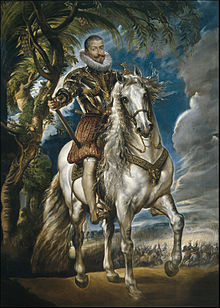Emperor Karl V after the battle of Mühlberg

|
| Emperor Karl V after the battle of Mühlberg |
|---|
| Titian , 1548 |
| Oil on canvas |
| 332 × 279 cm |
| Museo del Prado |
The painting Emperor Karl V after the Battle of Mühlberg is a painting by Titian from 1548 . The equestrian portrait was painted with oil paint on canvas and is now in the Museo del Prado in Madrid .
Image type
The portrait of Titian, which shows Emperor Charles V as victorious general after the battle of Mühlberg, is to be seen against the background of the tradition of the equestrian portrait, which was of central importance within the genre of the portrait of a ruler . The riding horse has always been considered a privilege and attribute of the aristocracy, it was an iconologically significant demonstration of imperial power and was already manifested in the famous equestrian statue of Marcus Aurelius in Rome . Those artists who had to portray generals and mercenary leaders also referred to this example from antiquity, such as Donatello , who designed and cast a monument to Erasmo da Narni, known as Gattamelata in Padua ; or Andrea del Verrocchio , who immortalized Bartolomeo Colleoni in an equestrian statue in their hometown of Venice . Titian was born in Venice while the second monument was being completed.
Image description and story
The Emperor can be by Titian in full armor, on a with a saddle pad spruce and headdresses warhorse represent. The portrayed holds a lance in his right hand. Dusk is falling in the background, the day is over, the battle is over, the ride home is imminent. The battle is completely excluded from the composition.
In the battle of Mühlberg, the imperial army of Charles V defeated the troops of the Schmalkaldic League on April 24, 1547 , thus winning the Schmalkaldic War for the emperor. One of the leaders of the Protestants, Elector Johann Friedrich von Sachsen , was captured. However, little is noticeable of this triumph in Titian's portrayal. Charles V was 47 years old at the time and had fought many wars and battles. Most of all the religiously motivated struggles against his own subjects rubbed him off. Titian does not show Karl as a triumphant, but as a general and emperor who wins with dignity.
Already in 1533 Titian was raised to the nobility by Charles V and appointed court painter . The painting itself was created in 1548 when the Emperor ordered Titian to Augsburg , where the Reichstag was taking place. With this body, also known as the Armored Reichstag , Charles V failed with his plans to overthrow Lutheranism and to establish a strong imperial power in Germany. The electors, but also the imperial estates, offered energetic resistance to the ideas of the ruler. The Protestants were defeated militarily by the victory at Mühlberg, but not politically. This is probably also the reason why the triumph of the victor is only expressed to a very limited extent in Titian's painting. Another detail: As in the portrait with the Ulmer Mastiff (1532, Kunsthistorisches Museum Wien ), the artist also reproduced the chin of the emperor, who suffered from a misaligned jaw, here too.
reception
With this equestrian portrait, Titian established a type that Rubens later took up again in numerous variations, such as the famous portrait of the Duke of Lerma (1603) or the portrait of Cardinal Infante Ferdinand of Spain (around 1634).
In Rubens' version, the duke appears before the battle, which is reduced to a hill in the background. Horse and rider face the viewer head-on, this form of representation was felt to be a sensation. In addition, Rubens underlines the majesty of the duke through the view from below. The numerous equestrian portraits of Diego Velázquez are also influenced by Titian and Rubens .
literature
- Norbert Schneider: portrait painting. Major works of European visual art 1420-1670 , Cologne 1999, ISBN 3-8228-6586-9
Individual evidence
- ^ Norbert Schneider: portrait painting. Major works of European visual art 1420-1670, Cologne 1999, p. 125

